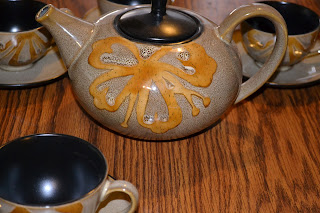I decided to make a black tea jam by cooking down strong black tea with apples (to provide petin) and lemon (to add acid). The fragrance of the jam was amazing while it was cooking, with the black tea as the predominant note. You do taste a lot of the apple. If you want a purer tea taste, just let the liquid drip through the strainer, and don't press the apple pieces through. Either way, you will wind up with more jam than you need to fill the cookies. Put the extra in a lidded jar and store in the referigerator.
What better way to show off the resulting tea-hued preserve than peeking through the window of a Linzer cookie? Linzer cookies already have almonds, and I upped the vanilla to make it a little more like the tea.
Black Tea Linzer Cookies
2 1/2 c. strong black tea (English Breakfast or similar)
2 c. sugar
Juice of one lemon
1 c. slivered almonds
2 c. all purpose flour
1/2 tsp. cinnamon
1/2 tsp. salt
1 c. butter, brought to room temperature
2/3 c. sugar
2 tsp. vanilla
2 egg yolks
Zest of 1 lemon
Combine apple pieces, tea, sugar and lemon in a medium pot over medium-high heat. Cook, stirring occasionally, until mixture starts to thicken. Continue, stirring frequently, until the mixutre reaches the soft ball stage. Place a strainer over a medium bowl. Pour the apple mixture in, letting the liquid drip through, then press the apples through. Stir to combine. Set aside until needed.
Using a stand or hand mixer, cream together the butter and sugar in a large bowl. Add the vanilla, egg yolks and lemon zest and beat to combine. Use a nut grinder to turn the almonds into nut meal. Add to butter mixture, and beat to combine. In a medium bowl, sift together the flour, cinnamon and salt. Add flour mixture to butter mixture in three additions, beating between additions. Divide dough in half. Wrap each half in plastic wrap and referigerate for an hour or up to overnight.
Preheat oven to 350 degrees. Line baking sheets with parchament paper. Roll out one half of cookie dough on floured surface to 1/4"thick and cut out using a pair of matching cookie cutters, one of which has a "window" in the middle (or using a separate smaller cutter to make holes in the top cookie). Bake for 12-15 minutes. Cool completely on cooling rack.
If you have referigerated everything overnight, heat 2/3 c. of the jam in a microwave for 20-30 seconds, or until it reaches an easily spreadable consistancy. Use a spoon to spread a thin layer of jam onto the base cookie. Place the cookie with the cutout on top. Carefully spoon more jam into the hole to fill it.






































.JPG)








.JPG)



